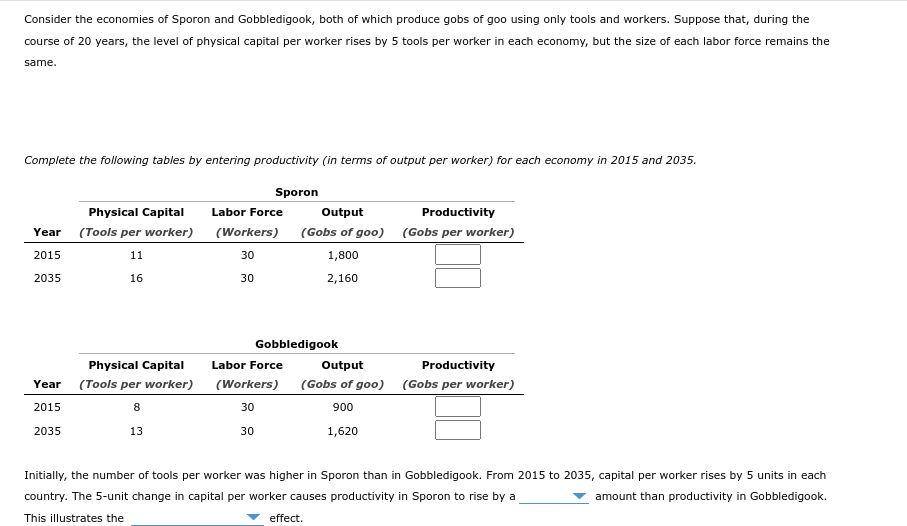Consider the economies of Sporon and Gobbledigook, both of which produce gobs of goo using only tools and workers. Suppose that, during the course of 20 years, the level of physical capital per worker rises by 5 tools per worker in each economy, but the size of each labor force remains the same. Complete the following tables by entering productivity (in terms of output per worker) for each economy in 2015 and 2035. Sporon Year Physical Capital (Tools per worker) Labor Force (Workers) Output (Gobs of goo) Productivity (Gobs per worker) 2015 11 30 1,800 2035 16 30 2,160 Gobbledigook Year Physical Capital (Tools per worker) Labor Force (Workers) Output (Gobs of goo) Productivity (Gobs per worker) 2015 8 30 900 2035 13 30 1,620 Initially, the number of tools per worker was higher in Sporon than in Gobbledigook. From 2015 to 2035, capital per worker rises by 5 units in each country. The 5-unit change in capital per worker causes productivity in Sporon to rise by a (a. larger, b. smaller) amount than productivity in Gobbledigook. This illustrates the (a. technology, b. human capital, c. catch-up, d. natural resources) effect.
Consider the economies of Sporon and Gobbledigook, both of which produce gobs of goo using only tools and workers. Suppose that, during the course of 20 years, the level of physical capital per worker rises by 5 tools per worker in each economy, but the size of each labor force remains the same. Complete the following tables by entering productivity (in terms of output per worker) for each economy in 2015 and 2035. Sporon Year Physical Capital (Tools per worker) Labor Force (Workers) Output (Gobs of goo) Productivity (Gobs per worker) 2015 11 30 1,800 2035 16 30 2,160 Gobbledigook Year Physical Capital (Tools per worker) Labor Force (Workers) Output (Gobs of goo) Productivity (Gobs per worker) 2015 8 30 900 2035 13 30 1,620 Initially, the number of tools per worker was higher in Sporon than in Gobbledigook. From 2015 to 2035, capital per worker rises by 5 units in each country. The 5-unit change in capital per worker causes productivity in Sporon to rise by a (a. larger, b. smaller) amount than productivity in Gobbledigook. This illustrates the (a. technology, b. human capital, c. catch-up, d. natural resources) effect.
Chapter20: Economic Growth In The Global Economy
Section: Chapter Questions
Problem 4P
Related questions
Question
Consider the economies of Sporon and Gobbledigook, both of which produce gobs of goo using only tools and workers. Suppose that, during the course of 20 years, the level of physical capital per worker rises by 5 tools per worker in each economy, but the size of each labor force remains the same.
Complete the following tables by entering productivity (in terms of output per worker) for each economy in 2015 and 2035.
Sporon
| Year | Physical Capital (Tools per worker) | Labor Force (Workers) | Output (Gobs of goo) | Productivity (Gobs per worker) |
|---|---|---|---|---|
| 2015 | 11 | 30 | 1,800 |
|
| 2035 | 16 | 30 | 2,160 |
|
Gobbledigook
| Year | Physical Capital (Tools per worker) | Labor Force (Workers) | Output (Gobs of goo) | Productivity (Gobs per worker) |
|---|---|---|---|---|
| 2015 | 8 | 30 | 900 |
|
| 2035 | 13 | 30 | 1,620 |
|
Initially, the number of tools per worker was higher in Sporon than in Gobbledigook. From 2015 to 2035, capital per worker rises by 5 units in each country. The 5-unit change in capital per worker causes productivity in Sporon to rise by a (a. larger, b. smaller) amount than productivity in Gobbledigook. This illustrates the (a. technology, b. human capital, c. catch-up, d. natural resources) effect.

Transcribed Image Text:Consider the economies of Sporon and Gobbledigook, both of which produce gobs of goo using only tools and workers. Suppose that, during the
course of 20 years, the level of physical capital per worker rises by 5 tools per worker in each economy, but the size of each labor force remains the
same.
Complete the following tables by entering productivity (in terms of output per worker) for each economy in 2015 and 2035.
Sporon
Physical Capital
Year (Tools per worker)
2015
11
2035
16
Physical Capital
Year (Tools per worker)
2015
8
13
2035
Labor Force
(Workers)
30
30
Output
(Gobs of goo)
1,800
2,160
Gobbledigook
Labor Force
(Workers)
30
30
Output
(Gobs of goo)
900
1,620
Productivity
(Gobs per worker)
Productivity
(Gobs per worker)
Initially, the number of tools per worker was higher in Sporon than in Gobbledigook. From 2015 to 2035, capital per worker rises by 5 units in each
country. The 5-unit change in capital per worker causes productivity in Sporon to rise by a
amount than productivity in Gobbledigook.
This illustrates the
effect.
Expert Solution
This question has been solved!
Explore an expertly crafted, step-by-step solution for a thorough understanding of key concepts.
This is a popular solution!
Trending now
This is a popular solution!
Step by step
Solved in 3 steps with 2 images

Knowledge Booster
Learn more about
Need a deep-dive on the concept behind this application? Look no further. Learn more about this topic, economics and related others by exploring similar questions and additional content below.Recommended textbooks for you

Exploring Economics
Economics
ISBN:
9781544336329
Author:
Robert L. Sexton
Publisher:
SAGE Publications, Inc

Principles of Economics 2e
Economics
ISBN:
9781947172364
Author:
Steven A. Greenlaw; David Shapiro
Publisher:
OpenStax

Exploring Economics
Economics
ISBN:
9781544336329
Author:
Robert L. Sexton
Publisher:
SAGE Publications, Inc

Principles of Economics 2e
Economics
ISBN:
9781947172364
Author:
Steven A. Greenlaw; David Shapiro
Publisher:
OpenStax